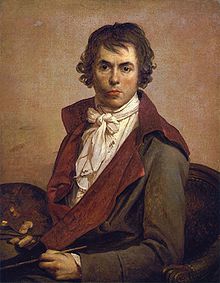
Jacques-Louis David, 1748–1825, French painter. David was the virtual art dictator of France for a generation. Extending beyond painting, his influence determined the course of fashion, furniture design, and interior decoration and was reflected in the development of moral philosophy. His art was a sudden and decisive break with tradition, and from this break “modern art” is dated.
David studied with Vien at the French Academy, and after winning the Prix de Rome (which had been refused him four times, causing him to attempt suicide by starvation) he accompanied Vien to Italy in 1775. His pursuit of the antique, nurtured by his time in Rome and his viewing of the ruins at Pompeii and Herculaneum, directed the classical revival in French art. He borrowed classical forms and motifs, predominantly from sculpture, to illustrate a sense of virtue he mistakenly attributed to the ancient Romans. Consumed by a desire for perfection and by a passion for the political ideals of the French Revolution, David imposed a fierce discipline on the expression of sentiment in his work. This inhibition resulted in a distinct coldness and rationalism of approach.
David's reputation was made by the Salon of 1784. In that year he produced his first masterwork,
The Oath of the Horatii (Louvre). This work and his celebrated
Death of Socrates (1787; Metropolitan Mus.) as well as
Lictors Bringing to Brutus the Bodies of His Sons (1789; Louvre) were themes appropriate to the political climate of the time. They secured for David vast popularity and success. David was admitted to the Académie royale in 1780 and worked as court painter to the king.
As a powerful republican David, upon being elected to the revolutionary Convention, voted for the king's death and for the dissolution of the Académie royale both in France and in Rome. In his paintings of the Revolution's martyrs, especially in his
Marat (1793; Brussels), his iron control is softened and the tragic portraits are moving and dignified. The artist was imprisoned for a time at the end of the Reign of Terror.
David emerged to become First Painter to the emperor and foremost recorder of Napoleonic events (e.g.,
Napoleon Crossing the Saint Bernard Pass, 1800–01;
Coronation of Napoleon and Josephine, 1805–07; and
The Distribution of the Eagles, 1810) and a sensitive portraitist (e.g.,
Mme Récamier, 1800; Louvre). In this period David reached the height of his influence, but his painting, more than ever the embodiment of neoclassical theory, was again static and deadened in feeling.
The Battle of the Romans and Sabines (1799; Louvre) portrayed the battle through the use of physically frozen figures.
During the Bourbon Restoration David spent his last years in Brussels, where he painted a masterful series of portraits, mainly of fellow refugees from the Napoleonic court. Although he belittled the genre, it was as a portraitist that he was at his most distinguished. Using living, rather than sculptured models, he allowed his spontaneous sentiment to be revealed in the closely observed portrayals. These last portraits, such as
Antoine Mongez and His Wife Angelica (1812; Lille),
Bernard (1820; Louvre), and
Zénaïde and Charlotte Bonaparte (1821; Getty Mus.) are enormously vital and in them the seeds of the new romanticism are clearly discernible.